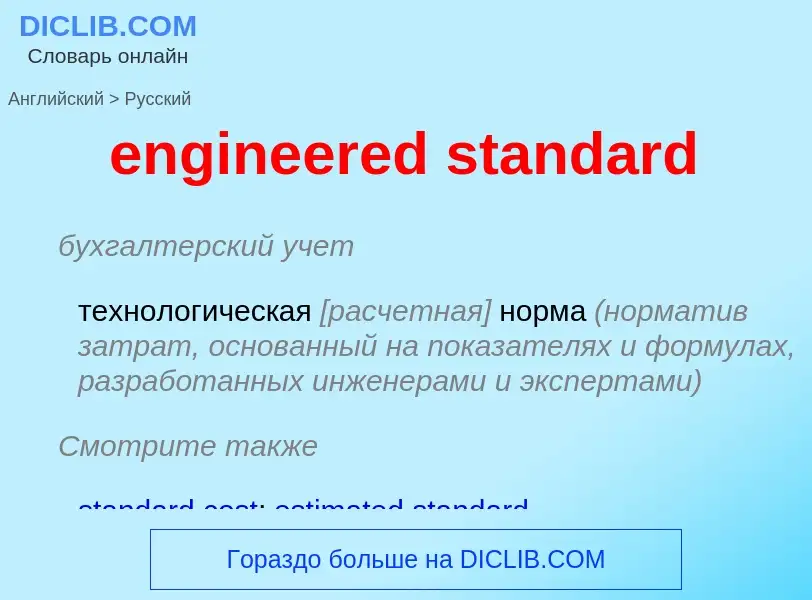Перевод и анализ слов искусственным интеллектом ChatGPT
На этой странице Вы можете получить подробный анализ слова или словосочетания, произведенный с помощью лучшей на сегодняшний день технологии искусственного интеллекта:
- как употребляется слово
- частота употребления
- используется оно чаще в устной или письменной речи
- варианты перевода слова
- примеры употребления (несколько фраз с переводом)
- этимология
engineered standard - перевод на Английский
бухгалтерский учет
технологическая [расчетная] норма (норматив затрат, основанный на показателях и формулах, разработанных инженерами и экспертами)
Смотрите также
общая лексика
вторичный эталон
[,i:vnɪŋ'stændəd]
общая лексика
"Ивнинг стандард" (ежедневная лондонская вечерняя газета консервативного направления; тир. ок. 505 тыс. экз.; издаётся компанией "Ассошиэйтед ньюспейперз" [Associated Newspapers] Основана в 1827)
Википедия

An engineered materials arrestor system, engineered materials arresting system (EMAS), or arrester bed is a bed of engineered materials built at the end of a runway to reduce the severity of the consequences of a runway excursion. Engineered materials are defined in FAA Advisory Circular No 150/5220-22B as "high energy absorbing materials of selected strength, which will reliably and predictably crush under the weight of an aircraft". While the current technology involves lightweight, crushable concrete blocks, any material that has been approved to meet the FAA Advisory Circular can be used for an EMAS. The purpose of an EMAS is to stop an aircraft overrun with no human injury and minimal aircraft damage. The aircraft is slowed by the loss of energy required to crush the EMAS material. An EMAS is similar in concept to the runaway truck ramp or race circuit gravel trap, made of gravel or sand. It is intended to stop an aircraft that has overshot a runway when there is an insufficient free space for a standard runway safety area (RSA). Multiple patents have been issued on the construction and design on the materials and process.
FAA Advisory Circular 150/5220-22B explains that an EMAS may not be effective for incidents involving aircraft of less than 11,000 kilograms (25,000 lb) weight. It also clarifies that an EMAS is not the same as a stopway, which is defined in FAA Advisory Circular 150/5300-13A, Section 312.
As of May 2017, the International Civil Aviation Organization (ICAO) has been working on developing a harmonized regulation regarding arresting systems.
Research projects completed in Europe have looked into the cost-effectiveness of EMAS. Arrestor beds have been installed at airports where the runway safety areas are below standards, and their ability to stop aircraft with minimal or no damage to the air frame and its occupants has proven to bring results far beyond the cost of installations. The latest report, "Estimated Cost-Benefit Analysis of Runway Severity Reduction Based on Actual Arrestments", shows how the money saved through the first 11 arrestments has reached a calculated total of 1.9 billion USD, thus saving more than $1 B over the estimated cost of development (R&D, all installations worldwide, maintenance and repairs reaching a total of USD 600 million). The study suggests that mitigating the consequences of runway excursions worldwide may turn out to be much more cost-effective than the current focus on reducing the already very low probability of occurrence.



![Higher EMAS bed with side steps to allow [[aircraft rescue and firefighting]] (ARFF) access and passenger egress.<ref name=Jacobs/> Higher EMAS bed with side steps to allow [[aircraft rescue and firefighting]] (ARFF) access and passenger egress.<ref name=Jacobs/>](https://commons.wikimedia.org/wiki/Special:FilePath/EMAS bed with side steps.jpg?width=200)
![The [[international prototype of the kilogram]] (IPK) is an artefact or prototype that was defined to have a mass of exactly one kilogram. The [[international prototype of the kilogram]] (IPK) is an artefact or prototype that was defined to have a mass of exactly one kilogram.](https://commons.wikimedia.org/wiki/Special:FilePath/CGKilogram.jpg?width=200)
![micrometer]]s. micrometer]]s.](https://commons.wikimedia.org/wiki/Special:FilePath/GaugeBlockMetricSet.jpg?width=200)





